Seat Alhambra 2008 Manual Online
Manufacturer: SEAT, Model Year: 2008, Model line: Alhambra, Model: Seat Alhambra 2008Pages: 295, PDF Size: 7.83 MB
Page 81 of 295

Cockpit79
Safety First
Operating instructions
Tips and Maintenance
Te c h n i c a l D a t a
On board computer with multifunction displayDescription
The information from the multi-function indicator and on board computer is
shown on these displays. The functions and indications of the multi-function
indicator are described in the chapter “Intruments”.
When the ignition is switched on, the on-board computer continually controls
the working of certain systems and vehicle components while the vehicle is
in motion.
Faults in the operation or urgent repairs or services are indicated by sound
signals and light warnings in red or yellow,depending on priority, on the
instrument panel.
In addition to the red and yellow symbols, text messages appear on the
driver's display.
Note
•
Depending on the model version or the country, it is possible that the
equipment installed in your vehicle does not display certain messages, or
they do not correspond with those in this manual. For this reason, we advise
you to consult the chapter “Luminous Indicators” for complementary informa-
tion on the different symbols and a description of their function.
Check operationVehicles with a manual gearbox
If faults exist, these will be indicated after the ignition is switched on. The
corresponding sound signal is emitted at the same time.
Vehicles with an automatic gearbox
Once the ignition is switched on with the lever in position P or N, the driver
warning appears on the display:
WITH CAR STOPPED, DEPRESS BRAKE TO SELECT GEAR
After selecting a gear ( R, D , etc) the warning is erased.
Fig. 49 Vehicle instru-
ment panel display with
telematic or navigation
system.Fig. 50 Display in vehicle
with on-board computer.
alhambra_ingles_0708 Seite 79 Mittwoch, 10. September 2008 10:55 10
Page 82 of 295
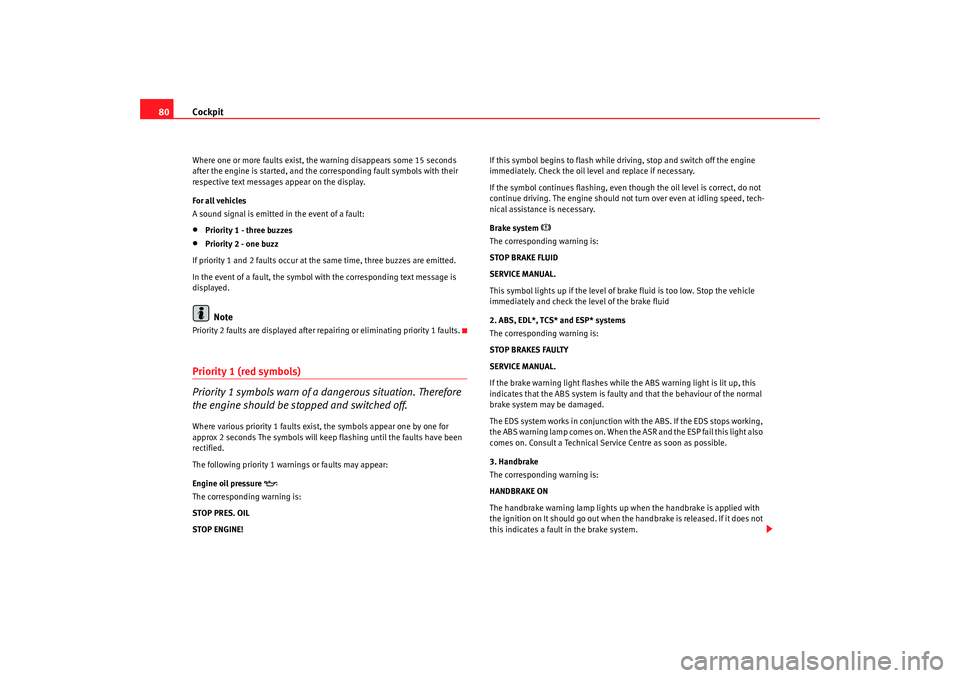
Cockpit
80Where one or more faults exist, the warning disappears some 15 seconds
after the engine is started, and the corresponding fault symbols with their
respective text messages appear on the display.
For all vehicles
A sound signal is emitted in the event of a fault:•
Priority 1 - three buzzes
•
Priority 2 - one buzz
If priority 1 and 2 faults occur at the same time, three buzzes are emitted.
In the event of a fault, the symbol with the corresponding text message is
displayed.Note
Priority 2 faults are displayed after repairing or eliminating priority 1 faults.Priority 1 (red symbols)
Priority 1 symbols warn of a dangerous situation. Therefore
the engine should be stopped and switched off.Where various priority 1 faults exist, the symbols appear one by one for
approx 2 seconds The symbols will keep flashing until the faults have been
rectified.
The following priority 1 warnings or faults may appear:
Engine oil pressure
The corresponding warning is:
STOP PRES. OIL
STOP ENGINE! If this symbol begins to flash while driving, stop and switch off the engine
immediately. Check the oil level and replace if necessary.
If the symbol continues flashing, even though the oil level is correct, do not
continue driving. The engine should not turn over even at idling speed, tech-
nical assistance is necessary.
Brake system
The corresponding warning is:
STOP BRAKE FLUID
SERVICE MANUAL.
This symbol lights up if the level of brake fluid is too low. Stop the vehicle
immediately and check the level of the brake fluid
2. ABS, EDL*, TCS* and ESP* systems
The corresponding warning is:
STOP BRAKES FAULTY
SERVICE MANUAL.
If the brake warning light flashes while the ABS warning light is lit up, this
indicates that the ABS system is faulty and that the behaviour of the normal
brake system may be damaged.
The EDS system works in conjunction with the ABS. If the EDS stops working,
the ABS warning lamp comes on. When the ASR and the ESP fail this light also
comes on. Consult a Technical Service Centre as soon as possible.
3. Handbrake
The corresponding warning is:
HANDBRAKE ON
The handbrake warning lamp lights up when the handbrake is applied with
the ignition on It should go out when the handbrake is released. If it does not
this indicates a fault in the brake system.
alhambra_ingles_0708 Seite 80 Mittwoch, 10. September 2008 10:55 10
Page 83 of 295
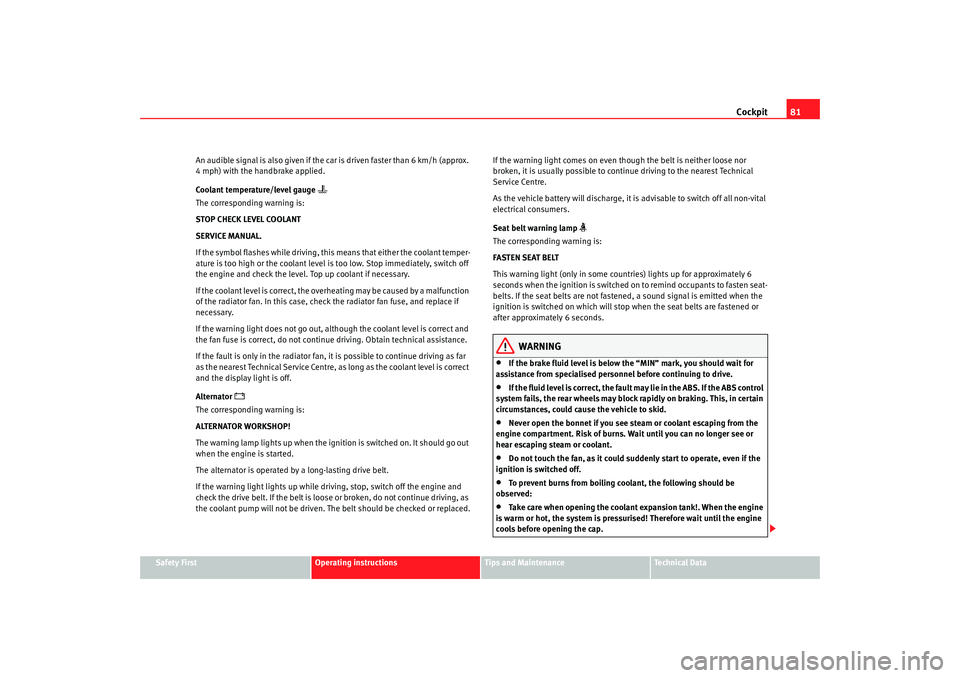
Cockpit81
Safety First
Operating instructions
Tips and Maintenance
Te c h n i c a l D a t a
An audible signal is also given if the car is driven faster than 6 km/h (approx.
4 mph) with the handbrake applied.
Coolant temperature/level gauge
The corresponding warning is:
STOP CHECK LEVEL COOLANT
SERVICE MANUAL.
If the symbol flashes while driving, this means that either the coolant temper-
ature is too high or the coolant level is too low. Stop immediately, switch off
the engine and check the level. Top up coolant if necessary.
If the coolant level is correct, the overheating may be caused by a malfunction
of the radiator fan. In this case, check the radiator fan fuse, and replace if
necessary.
If the warning light does not go out, although the coolant level is correct and
the fan fuse is correct, do not continue driving. Obtain technical assistance.
If the fault is only in the radiator fan, it is possible to continue driving as far
as the nearest Technical Service Centre, as long as the coolant level is correct
and the display light is off.
Alternator
The corresponding warning is:
ALTERNATOR WORKSHOP!
The warning lamp lights up when the ignition is switched on. It should go out
when the engine is started.
The alternator is operated by a long-lasting drive belt.
If the warning light lights up while driving, stop, switch off the engine and
check the drive belt. If the belt is loose or broken, do not continue driving, as
the coolant pump will not be driven. The belt should be checked or replaced.
If the warning light comes on even though the belt is neither loose nor
broken, it is usually possible to continue driving to the nearest Technical
Service Centre.
As the vehicle battery will discharge, it is advisable to switch off all non-vital
electrical consumers.
Seat belt warning lamp
The corresponding warning is:
FASTEN SEAT BELT
This warning light (only in some countries) lights up for approximately 6
seconds when the ignition is switched on to remind occupants to fasten seat-
belts. If the seat belts are not fastened, a sound signal is emitted when the
ignition is switched on which will stop when the seat belts are fastened or
after approximately 6 seconds.
WARNING
•
If the brake fluid level is below the “MIN” mark, you should wait for
assistance from specialised personnel before continuing to drive.
•
If the fluid level is correct, the fault may lie in the ABS. If the ABS control
system fails, the rear wheels may block rapidly on braking. This, in certain
circumstances, could cause the vehicle to skid.
•
Never open the bonnet if you see steam or coolant escaping from the
engine compartment. Risk of burns. Wait until you can no longer see or
hear escaping steam or coolant.
•
Do not touch the fan, as it could suddenly start to operate, even if the
ignition is switched off.
•
To prevent burns from boiling coolant, the following should be
observed:
•
Take care when opening the coolant expansion tank!. When the engine
is warm or hot, the system is pressurised! Therefore wait until the engine
cools before opening the cap.
alhambra_ingles_0708 Seite 81 Mittwoch, 10. September 2008 10:55 10
Page 84 of 295

Cockpit
82•
To protect your face, hands and arms from hot steam or fluid, cover the
fan cap with a large cloth in order to open it.
•
Take care to avoid coolant spilling on the exhaust pipe or any other hot
component as antifreeze is inflammable.
Priority 2 (yellow symbols)If a yellow symbol appears, a sound signal is emitted. The symbols indicate
a dangerous situation. The function shown should be controlled as fast as
possible. If various faults occur at the same time, the symbols will be
displayed one by one for approx. 2 seconds.
Oil level too low
The corresponding warning is:
CHECK LEVEL OIL
If the symbol lights up: stop, switch off the engine and check the oil level,
topping up where necessary.
Oil level too low
The corresponding warning is:
OIL SENSOR WORKSHOP!
If the symbol flashes this probably means that the oil level sensor is defec-
tive. The vehicle should immediately be taken to a Technical Service Centre.
It is possible to continue driving, but the oil level should be continually moni-
tored, e.g. every time the vehicle is refuelled.
Engine fault
- Petrol engine
- Diesel engine
The corresponding warning is:
ENGINE FAULT WORKSHOP!
If a fault in the running of the engine arises while driving, the corresponding
light will come on (petrol engine) or flash (diesel engine). In this case the
engine should be checked immediately by a Technical Service Centre.
Anti-lock brake system (ABS)
The corresponding warning is:
ABS FAULT
A fault in the ABS system is shown in the following manner:
If the ABS warning light comes on separately, it is possible to brake the
vehicle using the normal brake system (without ABS). Consult a Technical
Service Centre as soon as possible.
Electronic immobiliser
The corresponding warning is:
IMMOBILIS.ACTIVE
When the ignition is switched on, the vehicle key data is automatically
consulted. The warning light will flash to confirm that the data is being
checked
If an unauthorised key is used, the warning light will flash constantly. It will
not be possible to start the vehicle.
Tailgate/bonnet open display *
The corresponding warning is:
TA ILGATE OPEN
This warning light only indicates that the tailgate is open.
WARNING (continued)
alhambra_ingles_0708 Seite 82 Mittwoch, 10. September 2008 10:55 10
Page 85 of 295

Cockpit83
Safety First
Operating instructions
Tips and Maintenance
Te c h n i c a l D a t a
The warning light only goes off when the tailgate is completely closed ( to the
second position)
Windscreen washer*
The corresponding warning is:
TOP UP WASHER FLUID
This symbol lights up to indicate that the windscreen washer level is too low.
Top up windscreen and headlight washer fluid*
Fuel level low
The corresponding warning is:
PLEASE REFUELNavigation system*
If the vehicle has a navigation system it is possible to go from one display to
the other using the button on the windscreen wiper lever ( by holding it
pressed in for over 2 seconds):•
Navigation display
•
Multifunction display
When the navigation display or the multifunction display are activated, the
possible faults are mainly displayed on the on-board computer screen.
Instructions for the use of the SEAT navigation system are included in a sepa-
rate handbook.
Fig. 51 Button on the
windscreen washer lever:
Fig. 52 On-board
computer display:
alhambra_ingles_0708 Seite 83 Mittwoch, 10. September 2008 10:55 10
Page 86 of 295
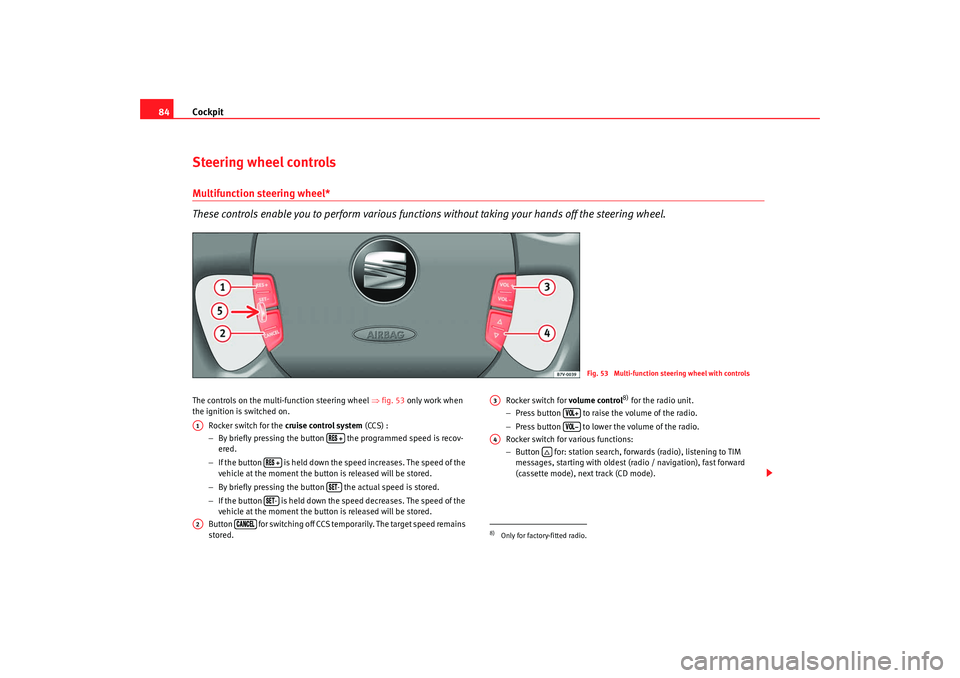
Cockpit
84Steering wheel controlsMultifunction steering wheel*
These controls enable you to perform various functions without taking your hands off the steering wheel.The controls on the multi-function steering wheel ⇒fig. 53 only work when
the ignition is switched on.
Rocker switch for the cruise control system (CCS) :
− By briefly pressing the button the programmed speed is recov-
ered.
− If the button is held down the speed increases. The speed of the
vehicle at the moment the button is released will be stored.
− By briefly pressing the button the actual speed is stored.
− If the button is held down the speed decreases. The speed of the
vehicle at the moment the button is released will be stored.
Button for switching off CCS temporarily. The target speed remains
stored. Rocker switch for volume control
8) for the radio unit.
− Press button to raise the volume of the radio.
− Press button to lower the volume of the radio.
Rocker switch for various functions:
− Button for: station search, forwards (radio), listening to TIM
messages, starting with oldest (radio / navigation), fast forward
(cassette mode), next track (CD mode).
Fig. 53 Multi-function steering wheel with controls
A1
-
-
A2
8)Only for factory-fitted radio.A3
A4
alhambra_ingles_0708 Seite 84 Mittwoch, 10. September 2008 10:55 10
Page 87 of 295
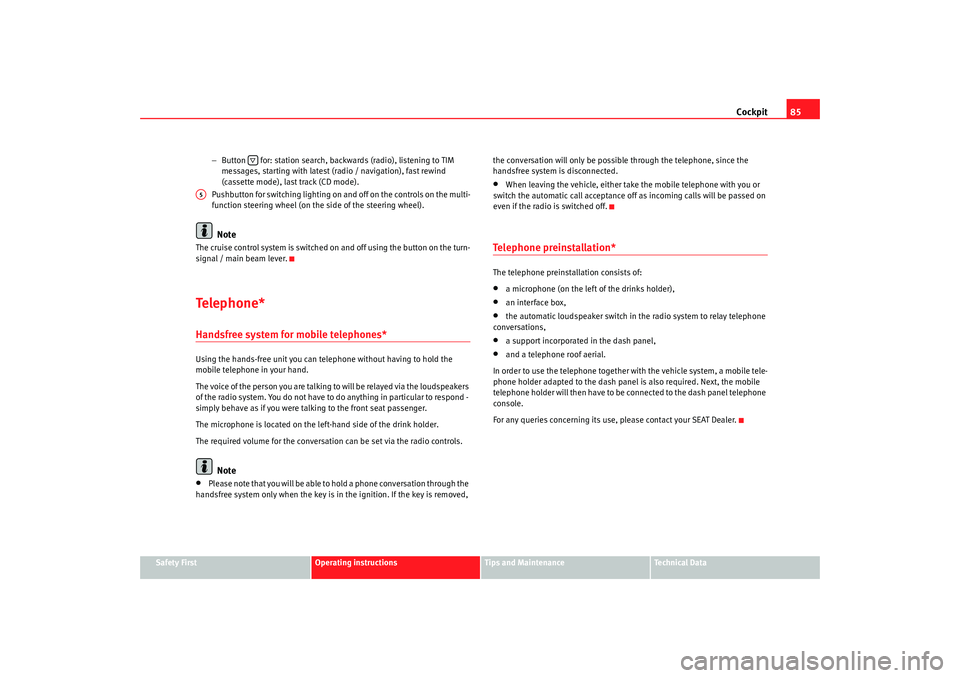
Cockpit85
Safety First
Operating instructions
Tips and Maintenance
Te c h n i c a l D a t a
−
Button for: station search, backwards (radio), listening to TIM
messages, starting with latest (radio / navigation), fast rewind
(cassette mode), last track (CD mode).
Pushbutton for switching lighting on and off on the controls on the multi-
function steering wheel (on the side of the steering wheel).
Note
The cruise control system is switched on and off using the button on the turn-
signal / main beam lever.Te l e p h o n e *Handsfree system for mobile telephones*Using the hands-free unit you can telephone without having to hold the
mobile telephone in your hand.
The voice of the person you are talking to will be relayed via the loudspeakers
of the radio system. You do not have to do anything in particular to respond -
simply behave as if you were talking to the front seat passenger.
The microphone is located on the left-hand side of the drink holder.
The required volume for the conversation can be set via the radio controls.
Note
•
P l e as e n o t e t h a t y o u w i l l b e a b l e t o h o l d a p h o n e c o n v e r sa t i o n t h r o u g h t h e
handsfree system only when the key is in the ignition. If the key is removed, the conversation will only be possible through the telephone, since the
handsfree system is disconnected.
•
When leaving the vehicle, either take the mobile telephone with you or
switch the automatic call acceptance off as incoming calls will be passed on
even if the radio is switched off.
Telephone preinstallation*The telephone preinstallation consists of:•
a microphone (on the left of the drinks holder),
•
an interface box,
•
the automatic loudspeaker switch in the radio system to relay telephone
conversations,
•
a support incorporated in the dash panel,
•
and a telephone roof aerial.
In order to use the telephone together with the vehicle system, a mobile tele-
phone holder adapted to the dash panel is also required. Next, the mobile
telephone holder will then have to be connected to the dash panel telephone
console.
For any queries concerning its use, please contact your SEAT Dealer.
A5
alhambra_ingles_0708 Seite 85 Mittwoch, 10. September 2008 10:55 10
Page 88 of 295
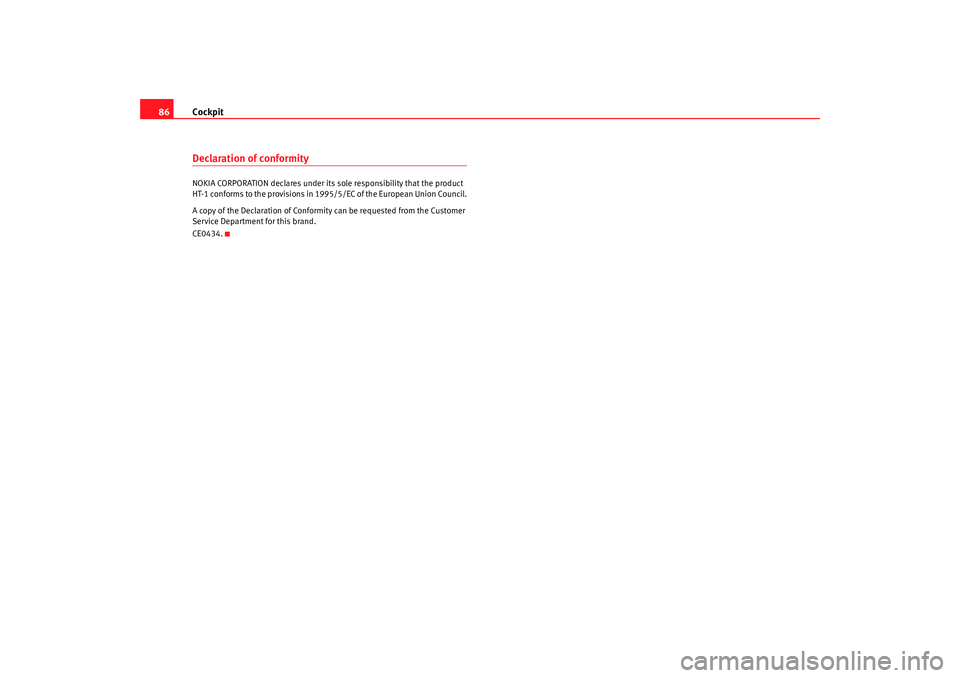
Cockpit
86CE0434.
alhambra_ingles_0708 Seite 86 Mittwoch, 10. September 2008 10:55 10
Declaration of conformityNOKIA CORPORATION declares under its sole responsibility that the product
HT-1 conforms to the provisions in 1995/5/EC of the European Union Council.
A copy of the Declaration of Conformity can be requested from the Customer
Service Department for this brand.
Page 89 of 295
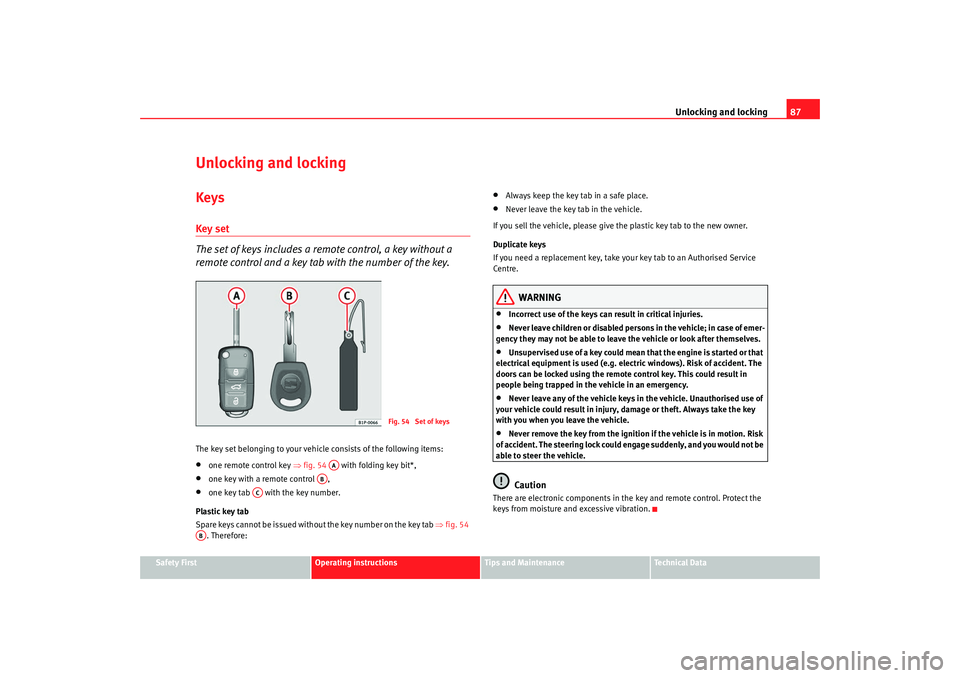
Unlocking and locking87
Safety First
Operating instructions
Tips and Maintenance
Te c h n i c a l D a t a
Unlocking and lockingKeysKey set
The set of keys includes a remote control, a key without a
remote control and a key tab with the number of the key.The key set belonging to your vehicle consists of the following items:•
one remote control key ⇒fig. 54 with folding key bit*,
•
one key with a remote control ,
•
one key tab with the key number.
Plastic key tab
Spare keys cannot be issued without the key number on the key tab ⇒fig. 54
. Therefore:
•
Always keep the key tab in a safe place.
•
Never leave the key tab in the vehicle.
If you sell the vehicle, please give the plastic key tab to the new owner.
Duplicate keys
If you need a replacement key, take your key tab to an Authorised Service
Centre.
WARNING
•
Incorrect use of the keys can result in critical injuries.
•
Never leave children or disabled persons in the vehicle; in case of emer-
gency they may not be able to leave the vehicle or look after themselves.
•
Unsupervised use of a key could mean that the engine is started or that
electrical equipment is used (e.g. electric windows). Risk of accident. The
doors can be locked using the remote control key. This could result in
people being trapped in the vehicle in an emergency.
•
Never leave any of the vehicle keys in the vehicle. Unauthorised use of
your vehicle could result in injury, damage or theft. Always take the key
with you when you leave the vehicle.
•
Never remove the key from the ignition if the vehicle is in motion. Risk
of accident. The steering lock could engage suddenly, and you would not be
able to steer the vehicle.Caution
There are electronic components in the key and remote control. Protect the
keys from moisture and excessive vibration.
Fig. 54 Set of keys
AA
AB
AC
AB
alhambra_ingles_0708 Seite 87 Mittwoch, 10. September 2008 10:55 10
Page 90 of 295
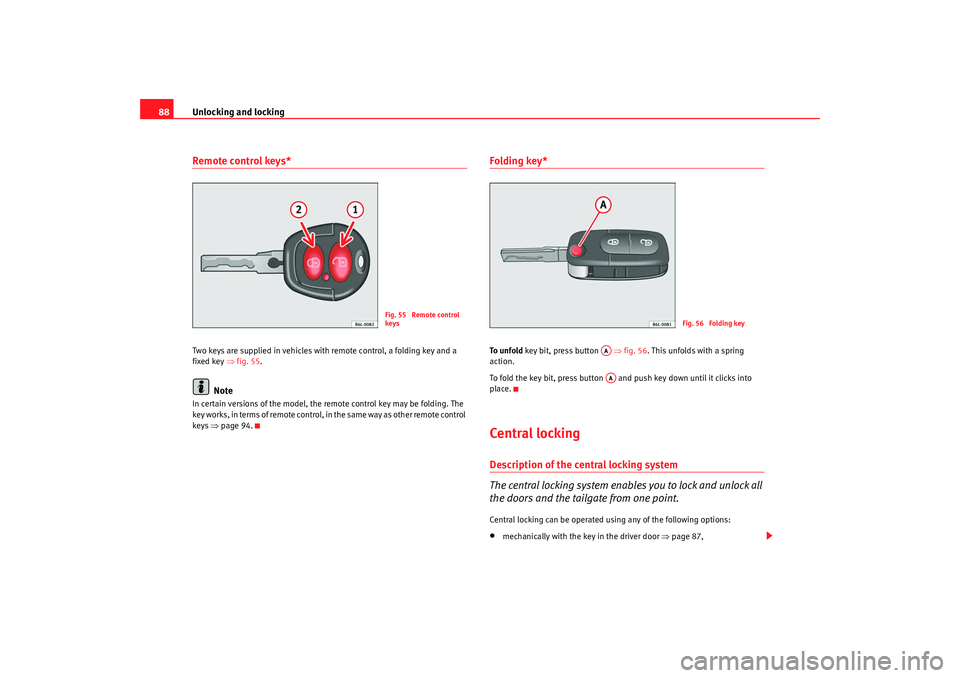
Unlocking and locking
88Remote control keys*Two keys are supplied in vehicles with remote control, a folding key and a
fixed key ⇒fig. 55 .
Note
In certain versions of the model, the remote control key may be folding. The
key works, in terms of remote control, in the same way as other remote control
keys ⇒page 94.
Folding key*To u n f o l d key bit, press button ⇒fig. 56 . This unfolds with a spring
action.
To fold the key bit, press button and push key down until it clicks into
place.Central lockingDescription of the central locking system
The central locking system enables you to lock and unlock all
the doors and the tailgate from one point.Central locking can be operated using any of the following options:•
mechanically with the key in the driver door ⇒page 87,
Fig. 55 Remote control
keys
Fig. 56 Folding key
AAAA
alhambra_ingles_0708 Seite 88 Mittwoch, 10. September 2008 10:55 10